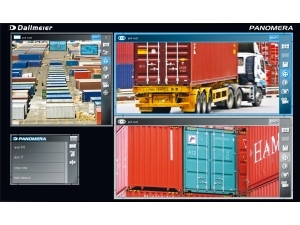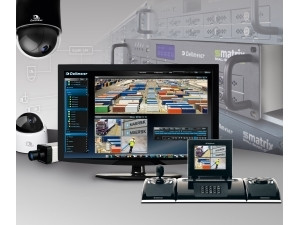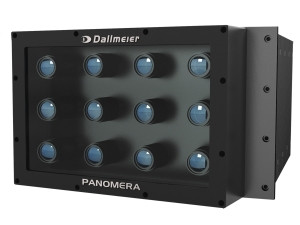
These days, video technology has become an indispensable element of the security arrangements at ports. With its introduction of the Panomera multi-focal sensor system, German developer and manufacturer Dallmeier has unveiled an entirely new approach to video surveillance of large areas. This unique technology offers many advantages for those responsible for port security. We spoke with Roland Meier, Head of Panomera Multifocal Sensor Systems at Dallmeier.
Mr Meier, what is so innovative about the Panomera system?
With the Panomera multi-focal sensor system, a huge area can be monitored from a single location extremely efficiently. The most impressive aspect of the product is that it combines the overall view with simultaneous top detail resolution: Even more distant objects are displayed with the same resolution as objects in the foreground of the picture.
That really sounds very simple...
In principle, it is exactly what the user wants from a video surveillance camera. The entire area observed by the camera should be displayed in uniformly high quality. But anyone who has ever zoomed in on an image will notice a marked difference: The farther you "move to the back" of the scene, meaning, zoom into the picture, the greater the loss of detail, causing the picture to become blurry. While objects in the foreground are certainly displayed with sufficient resolution, when the user attempts to enlarge objects from the background, they appear as so many ill-defined blocks. Let's consider an example taken from real life. Look at the image of a large port area. The number plates of the vehicles or the labels of the containers in the front of the picture are still legible, but in the back, the image loses definition when it is enlarged and it is no longer possible to make out the letters. This is why, when we developed the Panomera, one of our objectives was to ensure that the resolution never fell below the specified parameters, not even in the most distant areas of the image.
How is this high resolution possible?
We are using a completely new lens and sensor concept. In conventional cameras, the pixels are used uniformly within the sensor, that is to say, the available megapixels are distributed evenly throughout the entire image. But the actual scene is not two-dimensional like the sensor, it is three-dimensional - and the expanse of the lateral and depth perspectives becomes progressively larger the farther back you go. Now, if the pixels are distributed evenly on the camera sensor, this means the same number of pixels is available for capturing a much larger area than in the foreground of the image. And logically, as a result, more distant objects cannot be resolved any more when you zoom in.
With Panomera, on the other hand, we can guarantee uniform resolution over the entire object space. We do not use just a single optical device, but a multi-focal sensor system, meaning several lenses with different focal lengths. In this way, we "slice up" the scene so that each area has the optimum focal length assigned to it.
What advantages does this have for monitoring ports?
Panomera works well both for very wide panoramas and for areas involving great distances. In effect, it is as if you were to combine the advantages of an overview camera and a high optical zoom PTZ camera: Panomera records the entire area continuously, like an overview camera - unlike a PTZ camera, for example, with which only the currently active zoom area is recorded. But at the same time, you can move and zoom anywhere in the entire coverage area - and individuals are clearly recognisable even at distances of more than 160m!
May I ask you about this briefly? So continuous recording of the entire surveillance area is not standard practice?
Until now, no. Of course, fixed dome or box cameras always record the whole of the area they are monitoring. But these cameras are not equipped with an optical zoom, so they are not suitable for monitoring expansive areas, or at least only as overview cameras. This is why a lot of PTZ cameras are being used at the moment. These can be used to zoom and move within the scenes. But at the same time, PTZ cameras have a definite disadvantage: They can only ever record the area that the operator is currently watching live. If the operator is currently zooming in on the front-left portion of the image, only this area is being recorded. So if an incident were to take place at a different location at the same time, it would not be possible to review it afterwards. With Panomera, on the other hand, the entire scene is recorded continuously and in maximum detail resolution - regardless of which area the operator is viewing live. This makes it possible to analyse incidents after they have occurred.
Couldn't you also achieve this effect by using several HD cameras in conjunction with each other?
An operator can work much more efficiently with a single, synchronised system than he ever could with just multiple HD cameras strung together in line. The operator would have to concentrate on lots of individual images simultaneously. Moreover, the field viewing angles could never be synchronised with one another as well as is possible with a single, integrated multi-focal sensor system. Quite apart from the fact that the operator would be engaged in a constant "battle for resources" in order to obtain comparable resolution.

Another advantage of the Panomera sensor concept is a substantially higher dynamic range. Panomera works with several sensors, each of which selects its own exposure strategy in order to achieve ideal saturation. While with other cameras an average value is determined, Panomera can make distinctions more effectively: Light areas are exposed for a shorter time and dark areas for a longer time. As a result, situations with a large dynamic range can also be recorded with good quality, without overexposure or "drowned" black areas.
If the entire scene is monitored by just one camera, is it only possible for one security operator to work with the camera, or can several operators access it?
In contrast to PTZ cameras, with which only one operator can control the camera, with Panomera, an unlimited number of operators can navigate across the entire scene independently of each other. Although all operators are connected with the same camera, each of the individual users can select his view individually and zoom or pan as he desires. Or he can perform evaluations of the recordings at the same time. So analyses can be carried out by any number of employees at various workstations simultaneously; for example, one may be watching the overview image live, another may zoom in on a suspicious vehicle in the port area, while yet another is looking at the recording from an hour ago to see how some containers have been loaded onto a ship.
Do you not need enormous bandwidth for this?
Owing to the so-called multicast capability, several users can view the images from Panomera without requiring repeated transmission of the data via the network. This reduces the necessary bandwidth significantly.
How fluidly is movement represented in the images?
Panomera provides image material in real time and at high frame rates of up to 30 fps, which translates to completely fluid representation. And with Panomera, you can step back one image at a time through the recording until you can see exactly what has happened.
That all sounds very plausible, but at the same time extremely complex...
Quite frankly, it is difficult to describe Panomera in words and explain all of its features. You simply have to see it in action for real. I have had that experience very often when making presentations to customers: Everyone who sees the system with his own eyes very soon has that "a-ha" moment. We call it the "Panomera effect": Panomera far surpasses the limits of conventional cameras. That is why we are constantly stressing that Panomera is not just another camera that purports to offer more megapixels than the products of our competitors. That is not the point - Panomera represents an entirely new technology and a fundamentally different approach to the issue of video security.
What is the situation regarding price? A system like this must surely be very expensive.
Not at all: Panomera is the most cost-effective system on the market today! Of course, a Panomera is more expensive than a single conventional HD camera. But then you only need one Panomera system to cover the same area that previously required several cameras. Even so, the greatest savings are realised in expenses for the infrastructure. This really cannot be overemphasised. The most expensive factor in installing a camera is not the camera itself, but the infrastructure it needs, that is to say: camera masts, wiring, electricity supply, and so on. If you only need a single camera installation site, you save an enormous amount of money. For this reason alone, it would pay immense dividends to thoroughly calculate the cost of a Panomera-based project!
Would an existing video system have to be replaced completely if a port opts for a new Panomera solution?
No, existing cameras can be incorporated in the Panomera concept. Even so, the entire video system can be monitored and controlled using a single management system.
And while we are on the subject of integration; a mobile solution can be created without difficulty via our iPhone server. The images from Panomera can be displayed on an iPhone or iPad, for example. This results in faster response times and greater flexibility.
Panomera is not Dallmeier's only product...
We offer complete solutions from a single supplier, from cameras to recording and storage systems all the way through to video management and analysis.
What recording systems do you offer?
For recording the image data, Dallmeier offers different recorders and servers, depending on the individual requirements of each port. All devices have one thing in common though: high reliability and failure safety. All components are manufactured according to the highest quality standards and extensively tested prior to being shipped. Dallmeier uses the operating system Linux on all its recorders. It is regarded as being extremely stable in professional circles, as it practically never fails. In order to further enhance stability, the operating system was separated from the hard disks and saved on a flash memory. Depending on the application, the failure safety can be increased as needed. This can be done, for instance, through a redundant recording or the use of external storage systems.
How difficult is it to operate one of these video systems?
These systems are managed and controlled via professional management software, which makes operation very simple and intuitive. For example, with the aid of our SeMSy Security Management System, operational procedures and complex controls can be stored within the system, allowing staff a highly convenient and intuitive operation. The graphical user interface, into which site plans of the port can be integrated, provides every operator a quick overview of the cameras and corresponding monitors through a graphic complete overview.

In order to make the operation even more convenient, the system can be expanded by an ergonomic video management centre, the VMC-1 "Eagle". Clearly arranged across its three components (joystick, jog-shuttle and keyboard with monitor), it combines all the functionalities that can be expected from a modern video management system. Using the jog-shuttle, it is easy to find specific images within video sequences. By turning the jog-dial, security operators can conveniently navigate through individual frames. The joystick of the VMC-1 "Eagle" also allows for the easy control of PTZ cameras. Pan, tilt and zoom movements can thus be carried out intuitively. What distinguishes the VMC-1 "Eagle" is the possibility to display both recorded image material as well as live pictures on the integrated monitor. Site plans and search functions can also be displayed.
Dallmeier already has many references all over the world...
That is true. Video over IP products and solutions from Dallmeier are used worldwide in all kinds of projects - from small systems with only a few cameras, right up to large-scale projects with several thousand channels.
We do not mass produce products; we manufacture individually planned solutions that are tailored precisely to meet the needs of the respective customer and his specific requirements, for example, with regard to resolution quality, storage capacity or budget.
What is the situation regarding investment security? After all, development cycles for new technologies are becoming shorter and shorter...
Owing to the open system architecture of the Dallmeier solutions, the video system remains flexible and scalable. Future expansions or modifications are easily possible; even hybrid operation with devices from different generations presents no problems. Hence the IP video solutions by Dallmeier offer long-term investment protection.
Share
Dallmeier
Dallmeier has at its disposal more than 30 years' of experience in transmission, recording, as well as picture processing technology and is an outstanding pioneer of CCTV/IP solutions worldwide. This profound knowledge is used in the development of intelligent software and high-quality recorder and camera technologies enabling Dallmeier to not only offer standalone systems, but complete network solutions up to large-scale projects with perfectly integrated components. Right from the beginning, the company always focused on own innovative developments and highest quality and reliability. Dallmeier is the only manufacturer in Germany that develops and manufactures all components on its own. This includes the entire product range, from cameras to picture storage and transmission, to intelligent video analysis, and even individually adjusted management systems. Quality made by Dallmeier, made in Germany!
Over the years, Dallmeier has repeatedly given fresh impetus to the market with new developments and extraordinary innovations. The world's first DVR, for example, which introduced digital recording to the entire CCTV industry, came from Dallmeier. The multi-focal sensor system Panomera will have a similarly ground-breaking effect: This unique and novel camera technology will revolutionise the market and open up completely new possibilities to the video security industry. This, and the extensive experience in the CCTV and IP field, have led to a top position in the international market for digital video surveillance systems.
Editorial contacts